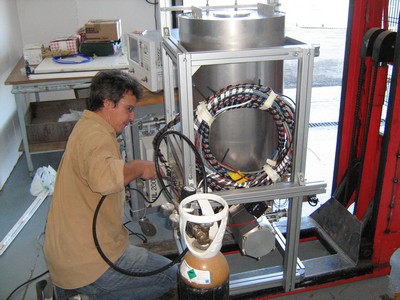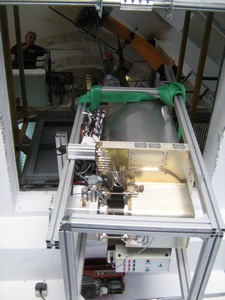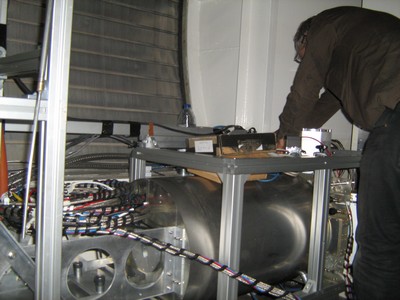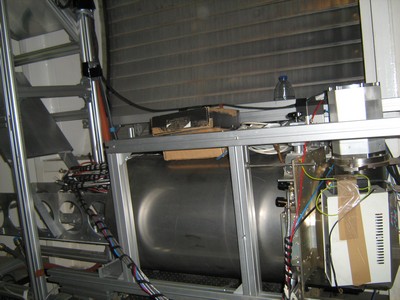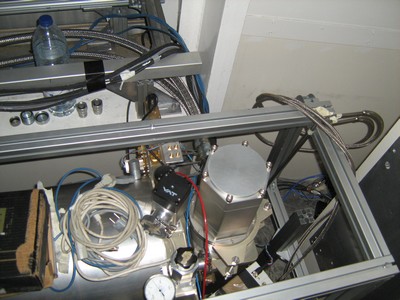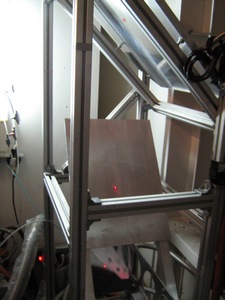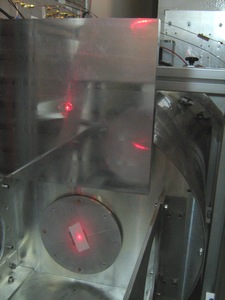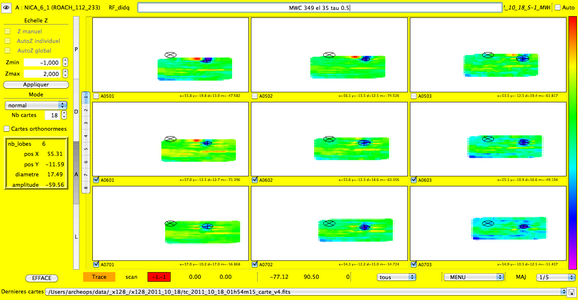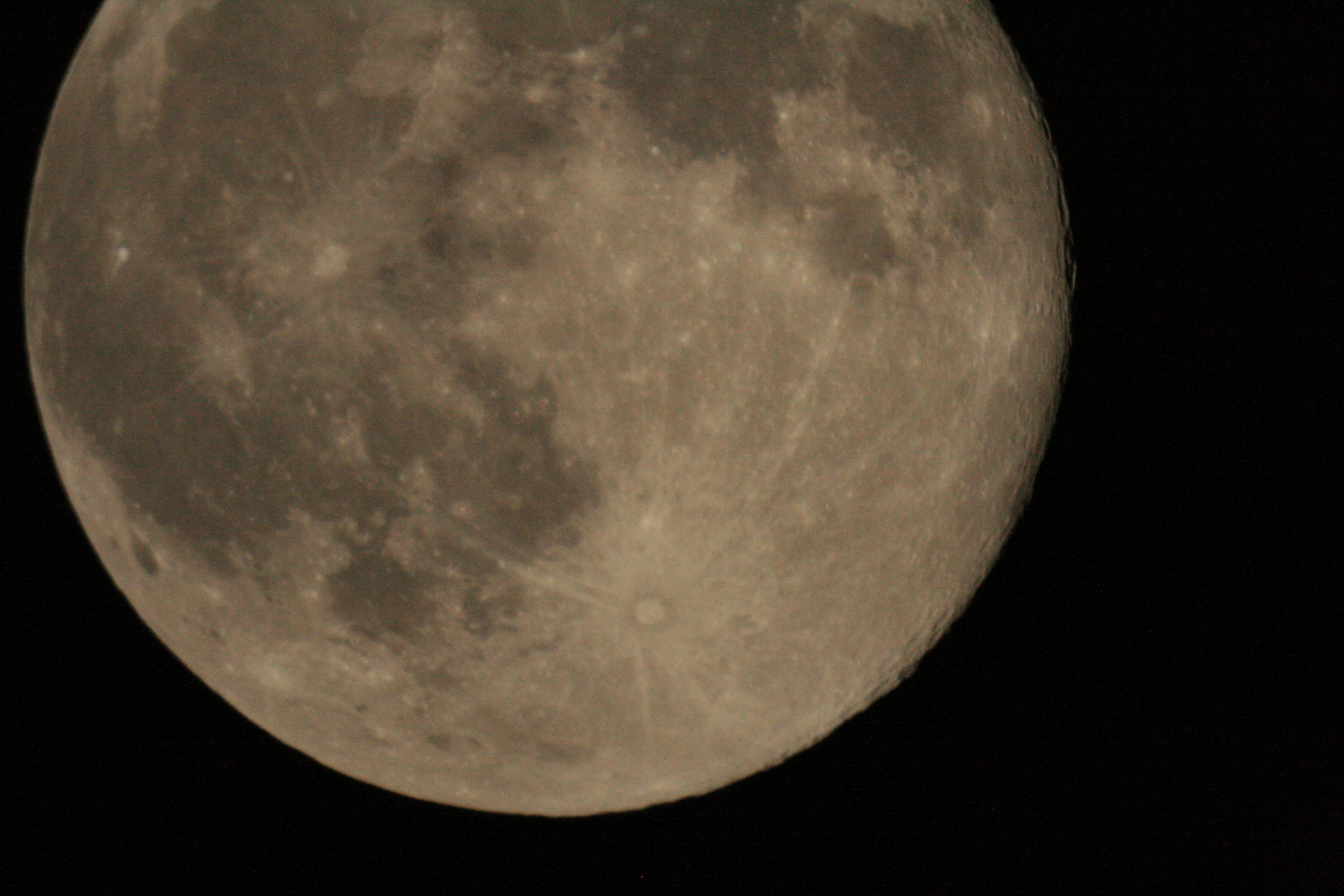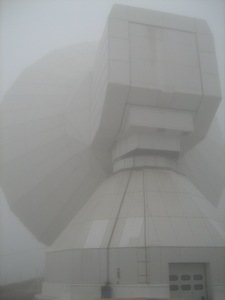NIKA run #3 (18 - 24. Oct 2011)
Test run plan:
# |
Dates |
Main Task |
Details |
Lead (Neel / IRAM) |
Support |
|
11.10. Tuesday |
|
Arrival of first visitors and truck in Granada |
|
|
|
12.10. Wednesday |
Mount and cool down |
Limited access to Rx-Cabin: ~ 11h - 17h |
Alain / Samuel |
Santiago |
|
13.10. Thursday |
Cool down / Network / System checks |
Limited access to Rx-Cabin: up to 2 hours in afternoon |
Alain / Samuel |
Miguel |
|
14.10. Friday |
Possible displacement of PTC compressor / cool, checks |
Limited access to Rx-Cabin: up to 2 hours anytime |
Alain / Samuel |
Dave ? Santiago ? |
|
15.10. Saturday |
Possible displacement of PTC compressor / laser alignment |
Limited access to Rx-Cabin: up to 2 hours anytime |
Alain / Samuel |
Dave ? Santiago ? |
|
16.10. Sunday |
cool down & checks or wait |
access to Rx-Cabin: 0 - 2 hours, probably not necessary |
Alain / Samuel |
|
|
17.10. Monday |
Observations (T21-11) |
start at 22h00 |
Alain / Samuel |
|
|
18.10. Tuesday |
Observations (T21-11) |
stop at 10h00, restart at 22h00 |
Alain / Samuel |
|
|
19.10. Wednesday |
Observations (T21-11) |
stop at 14h00, restart at 22h00 |
Alain / Samuel |
|
|
20.10. Thursday |
Observations (T21-11) |
stop at 14h00, restart at 22h00 |
Xavier, Alessandro / Samuel |
|
|
21.10. Friday |
Observations (T21-11) |
stop at 14h00, restart at 22h00 |
Xavier, Alessandro / Samuel |
|
|
22.10. Saturday |
Observations (T21-11) |
stop at 14h00, restart at 22h00 |
Xavier, Alessandro / Samuel |
|
|
23.10. Sunday |
Observations (T21-11) |
stop at 14h00, restart at 20h00 |
Xavier, Alessandro / Samuel |
|
|
24.10. Monday |
Observations (T21-11), Warm up |
stop at 14h00 |
Xavier, Alessandro / Samuel |
|
|
25.10. Tuesday |
Dismount and leave |
Access to Rx-Cabin: 10h30 - 14h00 |
Xavier, Alessandro / Samuel |
|
color table of the Run schedule
Staffing of the test run 3
- IRAM/Grenoble:
- 1 room: Samuel Leclercq (coordinator).
- Institut Néel:
- 3 rooms Oct 11 - Oct 18: Alain Benoit (PI) + (Christian Hoffmann), Alessandro Monfardini (co-PI) + Philippe Camus, Martino Calvo + (Angelo Cruciani).
- 4 rooms Oct 18 - Oct 25: Alain Benoit (PI), Alessandro Monfardini (co-PI), Martino Calvo + Angelo Cruciani, Christian Hoffmann + Nicolas Boudou.
- IPAG:
- 1 room Oct 17 - Oct 25: François-Xavier Désert.
- IRAM/Granada:
- 2 rooms: Operators: Juan / Salvador.
- 1 room: Astronomers of Duty: Sandra / Nicolas.
- 2 rooms: cooks and cleaning personal.
- 1 room: receiver engineer.
- 2 rooms: several from various groups.
- Visitors astronomers (heterodynes):
- 2 rooms.
The total number of rooms at the Pico is 14 => always full with above room atribution.
For more details on traveling and presences dates see the color table of the NIKA staff schedule.
List of astronomical targets
Complementary information
Minutes of the September 9 2011 meeting for the preparation of the NIKA run 3
Test plan document as previous years probably not necessary since it would be redondant with all the above information (however if somebody thinks it would still be useful, please tell me and I'll write a test plan similar to previous years - Samuel).
Arrays information
BAND 1.25mm (dichroic in transmission) - NICA_8c (132 pixels array, Hilbert dual-polarisation design, pixels pitch 2.3mm on both x and y <=> 1.23 Fλ with the current optics), 20nm (IRAM film), substrate 0.3mm, backshort 0.7mm. Amplifier Caltech SiGe (0.5-4GHz). From laboratory measurements we estimate an NET of about 2.5-4 mK/sqrt(Hz) per pixel. Resonances at 1.3-1.5GHz.
BAND 2mm (dichroic in reflection) - NICA_8c (132 pixels array, Hilbert dual-polarisation design, pixels pitch 2.3mm on both x and y <=> 0.77 Fλ with the current optics), 20nm (IRAM film), substrate 0.4mm, backshort 1.1mm. Amplifier IRAM 1-2GHz. From laboratory measurements we estimate an NET of about 4-6 mK/sqrt(Hz) per pixel. Resonances at 1.3-1.5GHz.
Day to day log book of observations
Offline processing results
Daily reports
Monday 10 October 2011
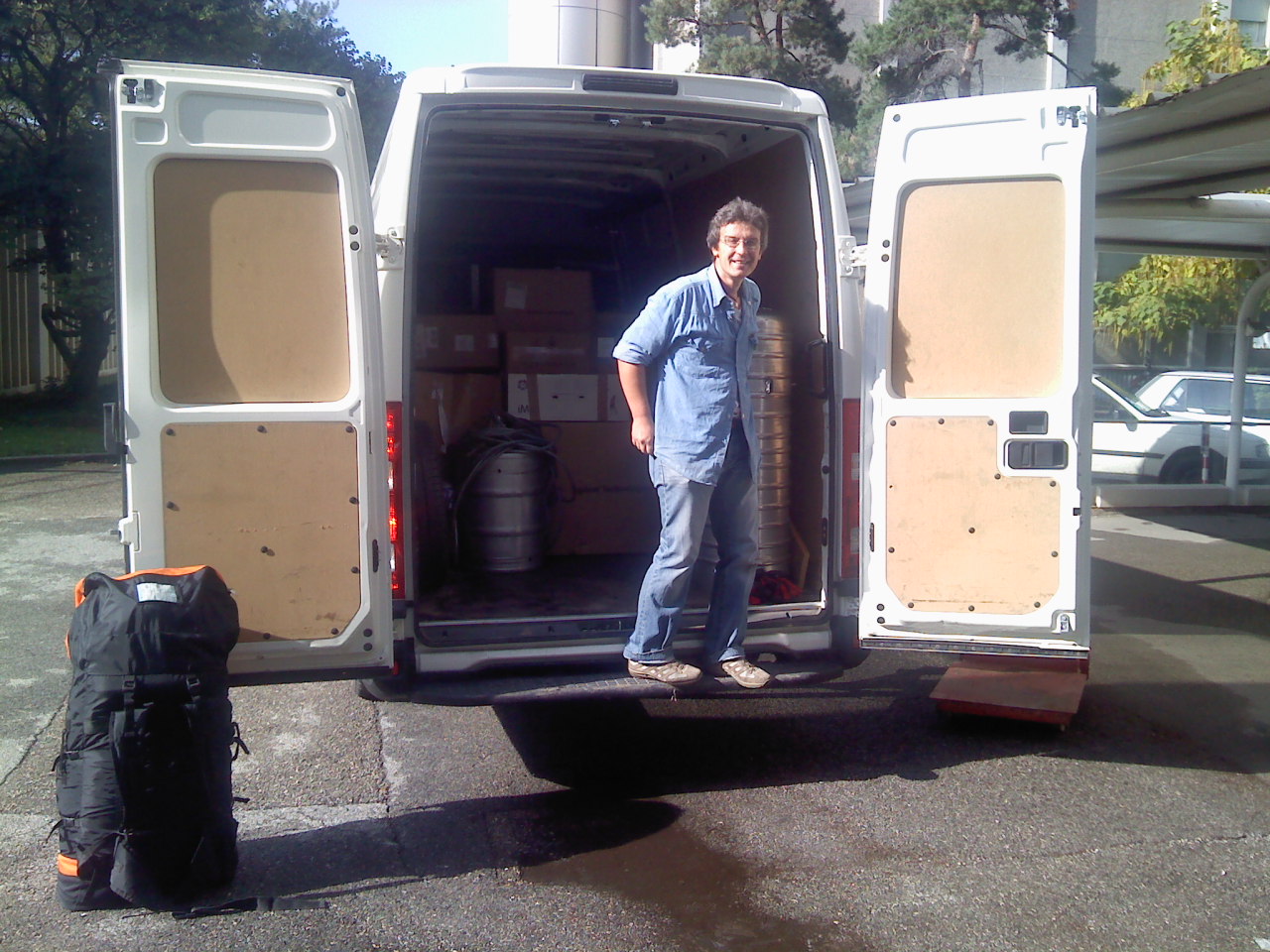
Tuesday 11 October 2011
The van left on Tuesday fully loaded and with 4 inflated tyres and one spare for Spain (Alessandro, Philippe and Martino are driving). Samuel and Alain to join them in Granada.
Wednesday 12 October 2011
Unloading has started at Pico Veleta.
Beside a leak in the cryostat, a connector size problem with the compressor and the explosion of one of the foot of the anti-vibration table, the installation of NIKA and its auxiliary equipment went fine and smoothly. System pumped, cryocooler switched on, temperature decreasing gently ==> so far so good.
|
Thursday 13 October 2011
Between 15h15 and 16h25 we changed the feet of the anti-vibration table (lift NIKA, put aluminum legs on it, remove the table, change the feet, put everything back in place), installed the roach boards, and plug all the electronics. The cryostat is cooling down slowly... maybe a bit too slow, so we put a bit more pressure in the compressor. Now the cooling rate seems OK, but it is still too soon to know whether we will be cold enough to start the dilution; if we can't reach the base temperature of the crycooler tomorrow we will have to bring the compressor up in the cabin. Hope fully this will not be necessary.
After discussions between the NIKA team, Santiago, and the 2 project PI of the afternoon and night (N. Biver and C.Thum) we have taken the decision to do the laser alignment tonight at 2h30; that's the slot which arrange the best everybody.
We did the laser alignment as planed, it went fine and took exactly 1 hour from the moment Clemens stopped his scan to the moment we returned in the control room. Near 4h in the morning the cryocooler reached a base temperature of ~5K: colder as ever, even better than in lab! We start the condensation of the He3-He4 mix; the dilution will cool down the array stage in the morning.
|
Friday 14 October 2011
This morning the detectors reached their base temperature around 80mK. The resonances of the KIDs are there for the 2 arrays, and the noise spectrum is pretty flat. Little problems to solve: temperature oscillations, resonances shifts, spikes that looks like cosmics. Nothing bad, things are doing well.
Between 16h and 17h we tried to do a 1st look at the sky... and were unsuccessful due to 2 stupid mistakes plus 1 unfortunate event:
1) For a long time we couldn't make the telescope obey our Pako command (though we had DOSUBMIT YES), we thought something was wrong with the choice of RECEIVER (we tried BOLO, then E090), or with BACKEND, or other PaKo choice that was wrong... but in the end we discovered that for some reason our project name (t21) had not been correctly set in the NCS when we logged on, so that the current project name was our predecessor's (001-11) !
2) We had no pointing information recorded in the NIKA data, we also though it was something wrong with the choice of RECEIVER or something else with our Pako commands, but found out that in the program we use to collect the ELVIN data, the line that gets this information had been commented out for a debugging reason (following an update done sometime before we got telescope time).
3) At the time we had the telescope the strongest source from our list that was neither too high (zenith) nor too low (horizon) was ~3Jy... and hidden by the clouds... so we saw nothing.
=> We gave back the telescope to N.Biver because we didn't want to eat too much of his time. Lesson learned, we'll give another try at 4h, and we'll don't make those mistakes again. In the List of astronomical targets page I updated the "Pako for NIKA" memo with this warning, and added a list of IRAM pointing sources (catalog always available in the pako cessions at the telescope) including some flux information.
In the meantime, "playing" a bit with the dilution we stopped the temperature oscillations.
Night Friday - Saturday 15
We have observed Uranus at 4h something, at ~30 degrees elevation. It's there, we see it on the 2 arrays, but there's some work to do to understand the data...
Tau=0.5-0.6, for this elevation means that the atmosphere transparency is about 60% at 2mm and 25% at 1.25mm. Under these conditions, the signal on Uranus (20Jy at 2mm, 50Jy at 1.25mm) was about 2kHz for the 2mm and 500-1000Hz on the 1.25mm.
Saturday 15 October 2011
Fixed a problem with the electronics (modulation dIdQ) in the morning. It could have been a grave problem .. it was nothing in fact.
Goods so far : a) cryostat working well with the compressor in the basement. Cooling down achieved in 36h as foreseen; b) the new magnetic screen (Pb at 1K + mu-metal at 300K) seems to work: we do not have, at a first look, the "magnetic jumps" we had last year during telescope slews (in particular in azimuth), and it seems we are relatively insensitive to other events in the cabin; c) the 2mm array seems to exhibit the same noise when compared to the measurements in Grenoble.
Problems : a) we have a large number (e.g. one 3-sigma glitch every 100 measure points, on both arrays) of "kind of poissonian" glitches (they are perfectly correlated on one array, but non-correlated from one array to the other .. like they were cosmic rays, but I hardly believe it .. for sure we failed in identifying a "stupid" cause like electronics or so); b) the 1mm array seems more noisy than in Grenoble (a possible hint: the SiGe cryogenic amplifier is colder than in Grenoble; we are investigating changing its polarisation to improve). K. Schuster points out that the noise T has been measured in Grenoble as a function of the physical T, and the result was that it was pretty T-independent. However, we have increased the polarisation on the amplifier (Vd from 1.6V to 1.8V) while monitoring with the VNA the S21 ripple and we have improved the noise on the 1mm array. IT is now at the Grenoble level (around 2Hz/sqrt(Hz) and flat).
In the afternoon we observed Venus, to test on sky effect of fixed electronic problem and upgrade on Camadia. We see the planet, at low horizon in a very cloudy sky, so with a very high and variable background (>300 KRJ total). Tonight at 4h we'll try a pixel map on Uranus, perspective is good, near midnight tau<0.1 or 1.5 mmpwv.
In the meantime we put some Pako scripts on ListAstroTargetNika3, to speed up the initialization sequence and to propose 4 standard OTFMAPs.
Sunday 16 October 2011
4h: the atmospheric conditions degraded quickly and strongly when we started to observe Uranus: strong wing and huge sky noise. But at least we see the planet and have enough data to work on the array geometry.
NikaBolometer IRAMGrenoble
22h15. Param written and committed (from MAC9) with the good rotation angle and magnification (grossissement). This comes by a comparison (fit) between the theoretical pixels position (identified in Grenoble using the sky simulator) and the Uranu map we have made last night (from the scan d_2011_10_16_04h34m27_Uranus_37).
Scale on focal plane : 10.3 arcsec/pixel on the 1mm array, 10.6 arcsec/pixel on the 2mm. The center of the pointing is found at about (7,5) pixels from the bottom/bown corner of the array. Very close to the geometrical center of the array. Moreover, the difference between the two arrays is less than 0.5 pixels (means the alignment between the two arrays is good). So now we should have the pointing of every pixel separately in the FITS.
The field rotation we have found on this Uranus map is 112deg, perfectly matching the expected value 90deg+EL. EL was 22deg when we observed Uranus at 4h Local Time (2 UT) on the 16/10/2011.
Monday 17 October 2011
3h00 (1h UT) we observe again Uranus at a higher elevation (40 degrees) to check the rotation of the array coordinates with elevation works well. We found a problem in transformation, it's being solved. We have enough data to work and give back the telescope to Clemens so that he can benefit of the awesome atmospheric conditions (according to Clemens measures with heterodynes: tau = 0.03 @3mm & 0.08 @1mm ==> 0.8 mm pwv !).
Lobes 3h20 - Exportés sur le MAC Florence V0_2011_10_17_03h28m59_lobe V2_2011_10_17_03h29m13_lobe
Christian and Xavier have arrived at the telescope. Many works ongoing to prepare the observations: array geometry in Camadia, Pako scripts, strategy for the observations of the night, pointing model, information about scanning speed (see scan speed info from Juan Peñalver) and several other items useful for the information (see Pako memo fro NIKA).
Obs Night 1: Monday - Tuesday 18
22h00 (20h UT) we start our 1st observing night. We decided to write a logbook of the observations on a dedicated wiki page: see ObsLogBook.
1st we tested various receiver and backends choices in Pako => only RECEIVER + BACKEND combination that works to create fits in ncsServer is to choose heterodynes devices: Receiver E090, Backend BBC. Then we did several pointing observations to find the best group of pixel to use for focus and pointing. Then do focus, then array geometry (pixels map), then many pointing observations of bright sources (> several Jy) to do a pointing model. IRC10216 at the end of the cession.
Tuesday 18 October 2011
Philip M. has joined us at the telescope. During the maintenance time, we took the opportunity to do some Zemax simulations, measurements and drawings to refine the plan for the future position of NIKA that would be compatible with GISMO. When we arrived in the cabin the M7 mirror (on top of the cryostat) had been moved, hopefully it was easy to put it back in place. We also worked on the source observation program, on new pako scripts, on fixing some problem with the data server, Juan worked out the pointing model for NIKA, other collaborators in Cardiff and in Grenoble started to work on the data of the night (see image below), Alain did some improvements in Camadia, and so on. The fridge is behaving well and smoothly.
Below a picture of the a map of Uranus with Camadia quick look, and a first stab at a map of Uranus by David Nutter from Cardiff:
|
Obs Night 2: Tuesday 18 - Wednesday 19
22h, 2nd obs night. As yesterday the starting is a bit slow due to (1) a little mistake in the init sequence of Pako, (2) pointing offset higher than expected. There was actually a sign error (reflection on a mirror not counted correctly ?) in one of the calculations needed to deduce the correct Nasmyth offset, once we figured that out, the pointings test were pretty good. After a pixel map and a focus we finally started science at past 1h: XMM_17, NGC1068, 4CO5.19, DRTau, FTTau, Crab, GMAur, NGC2023,M82, F10214+4724, GN20. See ObsLogBook for more details on the list of sources.
POLARISATION PARAMETERS FOR THE TWO ARRAYS: DAC=2 HF=25 (corresponding to about -45dBm on input, means -75dBm on the KIDs). The BF attenuator is 25 for the 2mm array and 28 for the 1mm array, but this is less important (just to adapt the output to the ADC dynamics)
TEMPERATURE OF THE CRYOSTAT: 90.00 mK +/- 0.02 mK (regulation power about 2.5uW) if not specified otherwise.
Wednesday 19 October 2011
After a patient re tuning of the detectors we recovered 7 more pixels named sleepy, dopey, happy, bashful, doc, grumpy, sneezy. Data processing is in progress on 3 independent fronts: Xavier here, Juan M.P and Nicolas P. in Grenoble, and Enzo, Dave and Robbie in Cardiff. Still few more improvements in Camadia. Make observing plan for the night. Update Pako help with more information (e.g. on Xephem) plus few more attached documents on the ListAstroTargetNika3 page...

Figure: Mars at 2mm, reduced with mopsic, all 115 pixels shown here. Some artefacts show up: all pixels show a "halo" which may be caused by the strong source. For all pixels, the "halo" shows-up in the lower right corner of these Az/El plots. About 20 pixels show a doubling of the source indicating cross-talk between pixels. About 4pixels show "shadows", about 9 seem blind. This map was a bit too small - some baseline missing at edges. (CK, 21-Oct-2011)
Obs Night 3: Wednesday - Thursday 20
22h: pointing, focus, geometry. 0h: start science with a deep integration on a SZ cluster (M2228), which is a novelty for NIKA obs, then some Herschel sources (XMM_M2, then some of Karl's sources (AATau, DOTau), a faint one (APM08279) and again a SZ (A665).
Thursday 20 October 2011
Work on processing, last acquisition improvements, network, data format (FITS files), focus sheet... A useful meeting with Carsten, Albrecht and the NIKA team about current status and preparation of the future installation of NIKA at the 30m.
Obs Night 4: Thursday 20 - Friday 21
Sky condition not good: tau ~0.7 decreasing slowly. Do few moderate sources we already observed in the past (Cyg A, MWC349, DR21, DR21_OH, W3OH), plus few longer integrations (SN1181, NGC2268, A665), plus the comet that Nicolas Biver is observing in the afternoon(Comet2009p1). Cloudy in the early afternoon at the end of the cession.
Friday 20 October 2011
Alain left by bike on the morning. Nicolas Boudou as joined the team. NIKA system stable now, work on processing and few other things aside.
Obs Night 5: Friday 21 - Saturday 22
Very cloudy in the afternoon, little rain. Start obs with an un-trustful tau meter (C.Coef very low). Conditions improve at the beginning of the run. Do a SZ cluster (M2228), Herschel distant galaxies/quasars (XMM_17, XMM_M6), a galactic source (OrionLBS23SM), and an extended region (NGC2071). Weather too bad in the morning, try a mapping of the moon through the clouds.
Here is a first map of the Moon made with the quick-look map-making program (nicarte). When passing on the illuminated portion the KIDs got saturated (300K). So please be warned: at the borders the map is strange. We made large maps (30x30 arcmin) and a smaller one at the center (dark). The smaller map at the center should be OK. No saturation, resonances centered at the (dark) Moon temperature. For further details, and in particular to get the full multiwavelenght dataset, please feel free to contact, even during the night/weekend, Philippe Camus (philippe.camus at grenoble.cnrs.fr).

|
Again, see ObsLogBook for more details on the observed sources.
Obs Night 6: Saturday 22 - Sunday 23: October 2011
Snow in the morning. Bad weather all day long. The sky cleared up about 1h after the beginning of the cession; this is a good surprise. Tau still high near midnight, but doing pointing, focus, pixels geometry on Uranus. Then a calibrator (MWC349), return to an engineering source (DR21_OH). Plan of the night: go back to several science sources to integrate deeper and have redundancies (start with M2228), and also look at a gamma ray burst (GRB111022B) which occurred in the late afternoon. Tau was OK for the 2mm band for few hours, then the weather got too bad near 5h.
Obs Night 7: Sunday 23 - Monday 24: October 2011
Again bad weather during the day. Once the tau became acceptable at night we tried to observe... but it was impossible because there was too much wind => too much sky noise on the detectors, then above telescope's limits.
Monday 24 October 2011
Bad weather: wind, snowy rain. Dismount NIKA.
|
Status of observations (24/10/2011, 3h00): spread sheet of sources with integrated time
